Площадь формы сердца Решение
ШАГ 0: Сводка предварительного расчета
ШАГ 1. Преобразование входов в базовый блок
Длина края квадрата в форме сердца: 10 метр –> 10 метр Конверсия не требуется
ШАГ 2: Оцените формулу
ШАГ 3: Преобразуйте результат в единицу вывода
178.539816339745 Квадратный метр –> Конверсия не требуется
4 Площадь формы сердца Калькуляторы
Площадь формы сердца формула
Площадь формы сердца = (1+pi/4)*Длина края квадрата в форме сердца^2
A = (1+pi/4)*le(Square)^2
Что такое форма сердца?
Кривая сердца представляет собой замкнутую кривую, имеющую форму сердца. Сердце хорошо известно как фигура на игральных картах помимо бубнов, крестов и пик. Если вы говорите о сердце, вы скорее имеете в виду фигуру сердца, чем кривую в форме сердца. Это сердце основано на квадрате, стоящем на одном кончике. На каждой из его двух верхних сторон прикреплен соответствующий полукруг.
From Wikipedia, the free encyclopedia
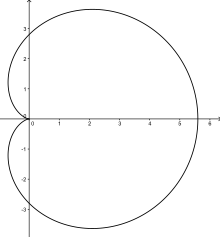

The caustic appearing on the surface of this cup of coffee is a cardioid.
In geometry, a cardioid (from Greek καρδιά (kardiá) ‘heart’) is a plane curve traced by a point on the perimeter of a circle that is rolling around a fixed circle of the same radius. It can also be defined as an epicycloid having a single cusp. It is also a type of sinusoidal spiral, and an inverse curve of the parabola with the focus as the center of inversion.[1] A cardioid can also be defined as the set of points of reflections of a fixed point on a circle through all tangents to the circle.[2]
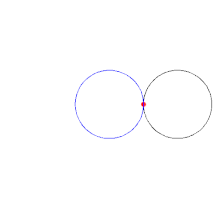
Cardioid generated by a rolling circle on a circle with the same radius
The name was coined by Giovanni Salvemini in 1741[3] but the cardioid had been the subject of study decades beforehand.[4] Although named for its heart-like form, it is shaped more like the outline of the cross-section of a round apple without the stalk.
A cardioid microphone exhibits an acoustic pickup pattern that, when graphed in two dimensions, resembles a cardioid (any 2d plane containing the 3d straight line of the microphone body). In three dimensions, the cardioid is shaped like an apple centred around the microphone which is the “stalk” of the apple.
Equations[edit]

Generation of a cardioid and the coordinate system used
Let 


- parametric representation:
and herefrom the representation in
- polar coordinates:
- Introducing the substitutions
and
one gets after removing the square root the implicit representation in Cartesian coordinates:
Proof for the parametric representation[edit]
A proof can be established using complex numbers and their common description as the complex plane. The rolling movement of the black circle on the blue one can be split into two rotations. In the complex plane a rotation around point 



- the rotation
around point
is
,
- the rotation
around point
is:
.
A point 



From here one gets the parametric representation above:
(The trigonometric identities 


Metric properties[edit]
For the cardioid as defined above the following formulas hold:
The proofs of these statement use in both cases the polar representation of the cardioid. For suitable formulas see polar coordinate system (arc length) and polar coordinate system (area)
Proof of the area formula
Proof of the arc length formula
Proof for the radius of curvature
The radius of curvature 

For the cardioid 
Properties[edit]

Chords through the cusp[edit]
- C1
- Chords through the cusp of the cardioid have the same length
.
- C2
- The midpoints of the chords through the cusp lie on the perimeter of the fixed generator circle (see picture).
Proof of C1[edit]
The points 
Proof for C2[edit]
For the proof the representation in the complex plane (see above) is used. For the points
and
the midpoint of the chord 
which lies on the perimeter of the circle with midpoint 

Cardioid as inverse curve of a parabola[edit]

Cardioid generated by the inversion of a parabola across the unit circle (dashed)
- A cardioid is the inverse curve of a parabola with its focus at the center of inversion (see graph)
For the example shown in the graph the generator circles have radius 
and its inverse curve
which is a parabola (s. parabola in polar coordinates) with the equation 
Remark: Not every inverse curve of a parabola is a cardioid. For example, if a parabola is inverted across a circle whose center lies at the vertex of the parabola, then the result is a cissoid of Diocles.
Cardioid as envelope of a pencil of circles[edit]
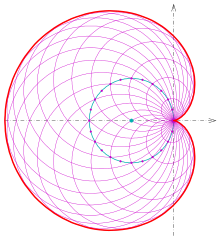
Cardioid as envelope of a pencil of circles
In the previous section if one inverts additionally the tangents of the parabola one gets a pencil of circles through the center of inversion (origin). A detailed consideration shows: The midpoints of the circles lie on the perimeter of the fixed generator circle. (The generator circle is the inverse curve of the parabola’s directrix.)
This property gives rise to the following simple method to draw a cardioid:
- Choose a circle
and a point
on its perimeter,
- draw circles containing
with centers on
, and
- draw the envelope of these circles.
Proof with envelope condition
The envelope of the pencil of implicitly given curves
with parameter 

which is the envelope condition. Note that 

Let 






which is equivalent to
The second envelope condition is
One easily checks that the points of the cardioid with the parametric representation
fulfill the non-linear system above. The parameter 
Cardioid as envelope of a pencil of lines[edit]

Cardioid as envelope of a pencil of lines
A similar and simple method to draw a cardioid uses a pencil of lines. It is due to L. Cremona:
- Draw a circle, divide its perimeter into equal spaced parts with
points (s. picture) and number them consecutively.
- Draw the chords:
. (That is, the second point is moved by double velocity.)
- The envelope of these chords is a cardioid.

Cremona’s generation of a cardioid
Proof[edit]
The following consideration uses trigonometric formulae for 




In order to keep the calculations simple, the proof is given for the cardioid with polar representation

Equation of the tangent of the cardioid with polar representation  [edit]
[edit]
From the parametric representation
one gets the normal vector 

With help of trigonometric formulae and subsequent division by 
Equation of the chord of the circle with midpoint  and radius
and radius  [edit]
[edit]
For the equation of the secant line passing the two points 
With help of trigonometric formulae and the subsequent division by 
Conclusion[edit]
Despite the two angles 

- The cardioid is the envelope of the chords of a circle.
Remark:
The proof can be performed with help of the envelope conditions (see previous section) of an implicit pencil of curves:
is the pencil of secant lines of a circle (s. above) and
For fixed parameter t both the equations represent lines. Their intersection point is
which is a point of the cardioid with polar equation 

Cardioid as caustic: light source 


Cardioid as caustic of a circle with light source (right) on the perimeter
Cardioid as caustic of a circle[edit]
The considerations made in the previous section give a proof that the caustic of a circle with light source on the perimeter of the circle is a cardioid.
- If in the plane there is a light source at a point
on the perimeter of a circle which is reflecting any ray, then the reflected rays within the circle are tangents of a cardioid.
Proof
As in the previous section the circle may have midpoint 

The tangent at circle point 



which is tangent of the cardioid with polar equation
from the previous section.
Remark: For such considerations usually multiple reflections at the circle are neglected.
Cardioid as pedal curve of a circle[edit]

Point of cardioid is foot of dropped perpendicular on tangent of circle
The Cremona generation of a cardioid should not be confused with the following generation:
Let be 

- The foots of perpendiculars from point
on the tangents of circle
are points of a cardioid.
Hence a cardioid is a special pedal curve of a circle.
Proof[edit]
In a Cartesian coordinate system circle 



The foot of the perpendicular from point 



which is the polar equation of a cardioid.
Remark: If point 

The evolute of a cardioid[edit]

A cardioid
Evolute of the cardioid
One point P; its centre of curvature M; and its osculating circle.
The evolute of a curve is the locus of centers of curvature. In detail: For a curve 

with 
For a cardioid one gets:
- The evolute of a cardioid is another cardioid, one third as large, and facing the opposite direction (s. picture).
Proof[edit]
For the cardioid with parametric representation
the unit normal is
and the radius of curvature
Hence the parametric equations of the evolute are
These equations describe a cardioid a third as large, rotated 180 degrees and shifted along the x-axis by 
(Trigonometric formulae were used: 
Orthogonal trajectories[edit]
An orthogonal trajectory of a pencil of curves is a curve which intersects any curve of the pencil orthogonally. For cardioids the following is true:
- The orthogonal trajectories of the pencil of cardioids with equations
are the cardioids with equations
(The second pencil can be considered as reflections at the y-axis of the first one. See diagram.)
Proof[edit]
For a curve given in polar coordinates by a function 
and for the derivatives
Dividing the second equation by the first yields the Cartesian slope of the tangent line to the curve at the point 
For the cardioids with the equations 

and
(The slope of any curve depends on 


Hence
That means: Any curve of the first pencil intersects any curve of the second pencil orthogonally.

4 cardioids in polar representation and their position in the coordinate system
In different positions[edit]
Choosing other positions of the cardioid within the coordinate system results in different equations. The picture shows the 4 most common positions of a cardioid and their polar equations.
In complex analysis[edit]

In complex analysis, the image of any circle through the origin under the map 
The Mandelbrot set contains an infinite number of slightly distorted copies of itself and the central bulb of any of these smaller copies is an approximate cardioid.
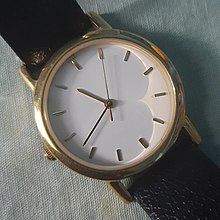
Cardioid formed by light on a watch dial.
Caustics[edit]
Certain caustics can take the shape of cardioids. The catacaustic of a circle with respect to a point on the circumference is a cardioid. Also, the catacaustic of a cone with respect to rays parallel to a generating line is a surface whose cross section is a cardioid. This can be seen, as in the photograph to the right, in a conical cup partially filled with liquid when a light is shining from a distance and at an angle equal to the angle of the cone.[5] The shape of the curve at the bottom of a cylindrical cup is half of a nephroid, which looks quite similar.

Generating a cardioid as pedal curve of a circle
See also[edit]
- Limaçon
- Nephroid
- Deltoid
- Wittgenstein’s rod
- Cardioid microphone
- Lemniscate of Bernoulli
- Loop antenna
- Radio direction finder
- Radio direction finding
- Yagi antenna
- Giovanni Salvemini
Notes[edit]
- ^ Weisstein, Eric W. “Parabola Inverse Curve”. MathWorld.
- ^ S Balachandra Rao . Differential Calculus, p. 457
- ^ Lockwood
- ^ Yates
- ^ “Surface Caustique” at Encyclopédie des Formes Mathématiques Remarquables
References[edit]
- R.C. Yates (1952). “Cardioid”. A Handbook on Curves and Their Properties. Ann Arbor, MI: J. W. Edwards. pp. 4 ff.
- Wells D (1991). The Penguin Dictionary of Curious and Interesting Geometry. New York: Penguin Books. pp. 24–25. ISBN 0-14-011813-6.
External links[edit]
![]()
Wikimedia Commons has media related to Cardioids.
- “Cardioid”, Encyclopedia of Mathematics, EMS Press, 2001 [1994]
- O’Connor, John J.; Robertson, Edmund F., “Cardioid”, MacTutor History of Mathematics archive, University of St Andrews
- Hearty Munching on Cardioids at cut-the-knot
- Weisstein, Eric W. “Cardioid”. MathWorld.
- Weisstein, Eric W. “Epicycloid–1-Cusped”. MathWorld.
- Weisstein, Eric W. “Heart Curve”. MathWorld.
- Xah Lee, Cardioid (1998) (This site provides a number of alternative constructions).
- Jan Wassenaar, Cardioid, (2005)
Mariam06Hani
+30
Ответ дан
1 месяц назад
Математика
1 – 4 классы
Нужно найти площадь сердца. Спасибо.

Ответ
5/5
(1 оценка)
1

vasilevanatasa4
1 месяц назад
Светило науки – 6 ответов – 0 раз оказано помощи
Ответ:
площадь сердца 9 квадратных сантиметров
Оцените пользу ответа

Мозг
Отвечающий
Остались вопросы?
Задать вопрос
«Если человек в школе не научится творить,
то и в жизни он будет только
подражать и копировать».
Л.Н.Толстой.
9 класс. Тема: Площадь круга
(учебник: Л.С. Атанасян, Геометрия 7-9)
Урок решения практических, проектно-исследовательских задач.
Урок по теме заключительный.
Цель:
Деятельностная: формирование у учащихся способностей к обобщению, структурированию и систематизации изученной темы.
Образовательная: систематизация учебного материала, аргументация и систематизация обнаруженных фактов.
Задачи урока:
Образовательные задачи: приобретение учащимися исследовательских знаний и умений: знаний специфики и особенностей процесса научного познания, ступеней исследовательской деятельности, методики научного исследования; формирование знаний по нахождению площади нестандартных геометрических фигур.
Развивающие задачи: формирование умений выделять проблемы, формулировать гипотезы, планировать эксперимент в соответствии с гипотезой, интегрировать данные, делать вывод.
Воспитательные задачи: развитие активного внимания, творческого мышления, самоориентации, развитие межличностного общения в паре.
Постановка учебной проблемы – подводящий к теме диалог. Он представляет собой систему посильных ученику вопросов и заданий, которые шаг за шагом приводят ученика к осознанию темы урока.
В структуру подводящего диалога могут входить задания:
- репродуктивные (вспомни формулы, выполни уже привычное)
- мыслительные (проанализируй, сравни)
Последний вопрос учителя обязательно будет на обобщение, а ответом на него станет формулировка учебной проблемы: как по данному рисунку вычислить площадь закрашенной фигуры.
Парная работа: пара планирует свою деятельность, распределяет обязанности и приступает к работе.
Учащиеся 9 класса имеют раздаточный материал по нахождению площадей нестандартных геометрических фигур.
Оборудование: доска SMART, презентация, раздаточный материал.
Важно акцентировать внимание выпускников на том, что они самостоятельно нашли алгоритм по вычислению площади закрашенной фигуры.
Необходимо дать возможность каждому ученику почувствовать важность его участия в процессе урока (так как учитываются рассуждения всех участников), развивать межличностное общение в паре, учить необходимости подчинять свои действия поставленной задачи и доводить начатую работу до конца. В решении проблем растет и развивается личность.
На уроке используется технология личностно-ориентированного обучения, ИКТ- использование новых педагогических инструментов таких как: интерактив, коммуникативность, производительность; исследовательский метод, учащиеся ориентируются в видах исследовательской деятельности и овладевают поисковыми методами.
Геометрическая сказка «В мире площадей»
Слушая математическую сказку, будем решать задачи на нахождение площадей разных геометрических фигур.
Часть 1.
Для того чтобы вырастить цветок, нужно вспахать землю и бросить в нее зерно. Только благодаря заботе и долгому уходу можно вырастить то, что потом будет радовать глаз красотой и совершенством. Давайте и мы бросим «зерно мысли» в поле площадей.
Для начала найдем площадь «зерна», расположенного в квадрате с длиной стороны a.

Часть 2.
Но вот зернышко брошено в землю, оно проросло, появился цветок. Контуры цветка расположены в квадрате, определим его площадь.

Интересно, что ответы получились одинаковые, но еще много таинственных неожиданностей.
Часть 3.
Изрядно потрудившись, надо отдохнуть. Приложим голову к «подушке» и найдем ее площадь.

Часть 4.
Отдохнув, мы отправляемся дальше. Кругом простираются зеленые леса и голубые озера. И вдруг на поверхности голубого озера мы видим серебряную рыбку, которая плещется в воде. Игривая рыбка поразила нас своей изящной формой и заставила задуматься о площади.

Часть 5.
Рыбка вильнула хвостом и уплыла. И тут мы заметили неподалеку красивый домик похожий на грибок. Дом стоял на высоком холме. Солнечные лучи грели его хрустальную крышу, отражаясь от нее сотнями золотых бликов. Необъяснимая сила тянула к «грибку». Это было желание скорее найти площадь домика без окна, мы стали решать задачу.

Часть 6.
Мы восхищались домиком с упоением. Но казалось, что хрустальный дворец вот – вот исчезнет. Прошло какое-то время, прежде чем нам удалось все отчетливо рассмотреть. Из дома вышла улыбающаяся девушка в разноцветном «фартуке». У нее была приветливая лучистая улыбка, добрый завораживающий взгляд. Мы познакомились с хозяйкой, имя у нее необычное – Площания. Мы стали разговаривать с хозяйкой о проделанном путешествии, незаметно, окинув взглядом фартук, нашли его площадь.

Часть 7.
Потом сидели за большим столом, принимали угощения Площании, решали задачи, рассказывали о себе. Нам не хотелось уходить из этого уютного, теплого и красивого дома с хрустальной крышей, сердце наше переполнялось радостью. Давайте найдем площадь нашего сердца.

Часть 8. Домашнее задание.
Нам надо торопиться домой. Еще раз, посмотрев на домик – «грибок» мы устремились вперед по дорожке, ведущей к озеру. По пути увидели квадратную клумбу, на которой рос один единственный цветок, он был симметричным и совсем не похож на другие земные цветки. Теперь нам стало понятно, что всё состояло из геометрических фигур. Восторгаясь творениями неизвестного сказочника, вы определите элементы симметрии цветка – центр и ось симметрии и найдите его площадь.

Учащиеся совершенно самостоятельно выдвигают свои гипотезы по нахождению площади фигур (варианты могут быть различные), пользуясь знаниями формул геометрических фигур, находят пути решения проблем поставленных на каждом этапе урока.
Рефлексия: Вернуться к поставленной проблеме (Как по данному рисунку вычислить площадь закрашенной фигуры)
- выделить геометрические фигуры на рисунке, площадь которых знаем;
- в зависимости от геометрических фигур необходимо сконструировать закрашенную фигуру;
- применить известные формулы геометрических фигур.
Какие ключевые слова сегодня на уроке использовались?
Квадрат, сторона квадрата, радиус, круг, сектор, площадь.
Таким образом, можно утверждать, что детская работа по конструированию нестандартных фигур строится по законам настоящей исследовательской научной работы.
Литература
- А.Азевич. В мире площадей. Газета “Математика” Издательского дома “Первое сентября” №8,1997.
- Атанасян А.С.Геометрия 7-9 (учебник для учащихся общеобразовательных учреждений) /– А.С.Атанасян М.: Просвещение, 2013.
Раздаточный материал
«В мире площадей»
Цель: Выработать алгоритм нахождения площади нестандартной геометрической фигуры и безошибочно применять формулы при вычислении площади геометрических фигур.
Парная работа: пара планирует свою деятельность, распределяет обязанности и приступает к работе.
Инструкция:
- внимательно слушать рассказ учителя;
- рассмотреть рисунок;
- по данному рисунку вычислить площадь закрашенной фигуры;
- выполнить конструирование на рисунке;
- применить знания формул площадей геометрических фигур;
- выполнить вычисление на листе.
- Найдите площадь «зерна», расположенного в квадрате с длиной стороны a.
 =
=
- Найдите площадь «цветка», расположенного в квадрате с длиной стороны a.
 =
=
- Найдите площадь «подушки», расположенной в квадрате с длиной стороны a.

- Найдите площадь «рыбки», расположенной в квадрате с длиной стороны a.

=
- Найдите площадь «домика», расположенного в квадрате с длиной стороны a.

- Найдите площадь «фартука», расположенного в квадрате с длиной стороны a.

- Найдите площадь «сердца», расположенного в квадрате с длиной стороны a.
 =
=
Домашнее задание: Найдите площадь «цветка», расположенного в квадрате с длиной стороны a.

Площадь сердца в передней проекции
admin1
Медицинские советы и статьи
12.03.2020
Размеры каждого желудочка определяются измерением перпендикуляра от перегородки до наиболее отдаленных от нее контуров желудочков; разделив расстояние ГД на 4, определяем, каким должен быть размер желудочков у данного больного,- так называемый вычисленный размер желудочков. Истинные размеры желудочков в норме должны равняться вычисленным с некоторым преобладанием левого желудочка. В практике часто встречаются случаи, когда в силу условно принятого угла поворота 50; линия А Б не равняется линии БВ, а каким-то отрезком (ВХ) выступает на левое реберно-позвоночное сочленение. Этот отрезок следует перенести за линию ГД вправо от реберно-позвоночного сочленения (ДХ). Нижний край перегородки в этих случаях определяется с учетом добавленного отрезка. Различают три степени увеличения желудочков порею. В левой боковой проекции определяют переднезадний диаметр сердца на месте наибольшей ширины сердца. Площадь сердца в передней проекции определяют следующим образом. Верхняя граница сердца не видна, ее надо провести, соединив дугообразной линией точку D с точкой G, нижнюю границу сердца определяют путем соединения дугообразной линией точки. Измеряют площадь сердца при помощи планиметра или переводят рентгенограмму на миллиметровую бумагу и высчитывают по ней число квадратных миллиметров. Рентгенологические методы определения объема сердца не нашли широкого применения в практике. Однако в настоящее время измерения объема сердца приобретают особое значение, так как в результате, например, операций на сердце могут наступать значительные изменения гемодинамики, ведущие к уменьшению размеров сердца. Объективным показателем этих изменений является количественная характеристика, получаемая методом измерения объема. Так, убедительные данные улучшения гемодинамики после митральной комиссуротомии получены с помощью этого метода в работе М. А. Иваницкой и И. И. Рушанова (1962).







![{displaystyle rho (varphi )={frac {left[r(varphi )^{2}+{dot {r}}(varphi )^{2}right]^{3/2}}{r(varphi )^{2}+2{dot {r}}(varphi )^{2}-r(varphi ){ddot {r}}(varphi )}} .}](https://wikimedia.org/api/rest_v1/media/math/render/svg/1e7cf0dc8bbc7c290a5046d1002a3ad215646126)
![{displaystyle rho (varphi )=cdots ={frac {left[16a^{2}sin ^{2}{frac {varphi }{2}}right]^{frac {3}{2}}}{24a^{2}sin ^{2}{frac {varphi }{2}}}}={frac {8}{3}}asin {frac {varphi }{2}} .}](https://wikimedia.org/api/rest_v1/media/math/render/svg/93226b1c859be822160a3403fd366ef703eb1db4)









































